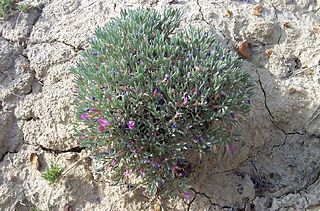
Astragalus is a large genus of over 3,000 species of herbs and small shrubs, belonging to the legume family Fabaceae and the subfamily Faboideae. It is the largest genus of plants in terms of described species. The genus is native to temperate regions of the Northern Hemisphere. Common names include milkvetch, locoweed and goat's-thorn. Some pale-flowered vetches are similar in appearance, but they are more vine-like than Astragalus.

Astragalus casei is a species of milkvetch known by the common name Case's milkvetch. It is native to the Mojave Desert and its sky island woodlands of eastern California and western Nevada.
Astragalus cimae is a species of milkvetch known by the common name Cima milkvetch. It is native to the Mojave Desert and its sky island woodlands of eastern California western Nevada, especially on calcareous soils, including the Cima Dome area in the Mojave National Preserve.

Astragalus didymocarpus is a species of milkvetch known by the common names Dwarf white milkvetch and Two-seeded milkvetch. It is native to the southwestern United States and northern Mexico, where it can be found in many types of habitat.

Astragalus filipes is a species of milkvetch known by the common name basalt milkvetch. It is native to western North America from British Columbia to California to Utah, where it grows in many types of habitat, especially dry areas.
Astragalus funereus is an uncommon species of milkvetch known by the common names Funeral Mountain milkvetch and black milkvetch.

Astragalus inyoensis is a species of milkvetch known by the common name Inyo milkvetch.

Astragalus kentrophyta is a species of milkvetch known by the common name spiny milkvetch. It is native to western North America from central to west Canada, to California, to New Mexico. It grows in rocky mountainous areas, such as the Sierra Nevada, and on plateaus.
Astragalus mohavensis is a species of milkvetch known by the common name Mojave milkvetch. It is native to the Mojave Desert of California and Nevada.

Astragalus oophorus is a species of milkvetch known by the common name egg milkvetch. It is native to the western United States, mainly California and Nevada, though one variety can be found as far east as Colorado. It is a plant of sagebrush and other dry habitat.
Astragalus panamintensis is a species of milkvetch known by the common name Panamint milkvetch.
Astragalus pauperculus is an uncommon species of milkvetch known by the common name depauperate milkvetch. It is endemic to northern California, where it is known from the northern Sacramento Valley and the lowest reaches of the Cascade foothills adjacent. It grows in chaparral and vernally wet grassland habitat. This is a very small annual milkvetch which grows in a delicate mat with stems no longer than 10 cm (3.9 in). The leaves are a few centimeters long and are made up of small widely spaced leaflets. The inflorescence bears two to seven flowers which are purple, sometimes with paler colored edges on their petals. Each flower is generally less than 1 cm (0.39 in) long. The fruit is a crescent-shaped legume pod between 1 and 2 cm long.

Astragalus platytropis is a species of milkvetch known by the common name broadkeel milkvetch. It is native to the western United States from Montana to California, where it lives at high elevation in alpine and subalpine plant communities. This is a small perennial milkvetch which forms a small patch of short silvery-green stems on rocky ground. The leaves may be up to 9 cm (3.5 in) long and are made up of several hairy leaflets. The inflorescence is a head of four to nine pale purple flowers, each just under 1 cm (0.39 in) long. The fruit is a bladdery legume pod which can exceed 3 cm (1.2 in) long.

Astragalus pulsiferae is a species of milkvetch known by the common name Ames's milkvetch. It is native to California and Nevada, and it is known but rare in Washington. It is known from many habitat types, including mountains and plateaus.

Astragalus purshii is a species of milkvetch known by the common names woollypod milkvetch and Pursh's milkvetch.
Astragalus tener is a species of milkvetch known by the common name alkali milkvetch. It is endemic to California, where it grows in both coastal and inland areas such as the Central Valley, especially in moist places.

Astragalus applegatei is a rare species of milkvetch known by the common name Applegate's milkvetch. Its scientific name is also spelt Astragalus applegatii. It is endemic to Klamath County, Oregon, where it is known from three populations, one of which is made up of only three plants. Much of the remaining habitat is seriously threatened by development, introduced plant species, and other forces. This is a federally listed endangered species of the United States.

Astragalus barrii is a species of flowering plant in the legume family known by the common name Barr's milkvetch. It is native to the United States, where it is a "regional endemic", occurring in parts of southwestern South Dakota, northeastern Wyoming, southeastern Montana, and Nebraska.

Astragalus microcymbus is a species of flowering plant in the legume family known by the common name Skiff Milkvetch. It is endemic to Colorado in the United States, where it is known from Gunnison County and the edge of Saguache County. It was discovered in 1945 by Rupert Barneby, a British botanist. Currently, Skiff Milkvetch is experiencing population declines and is listed as Threatened.

Astragalus molybdenus is a species of flowering plant in the legume family known by the common names Leadville milkvetch and molybdenum milkvetch. It is endemic to Colorado in the United States. If the separate species Astragalus shultziorum and Astragalus lackschewitzii are included in A. molybdenum the range expands into Wyoming and Montana.














